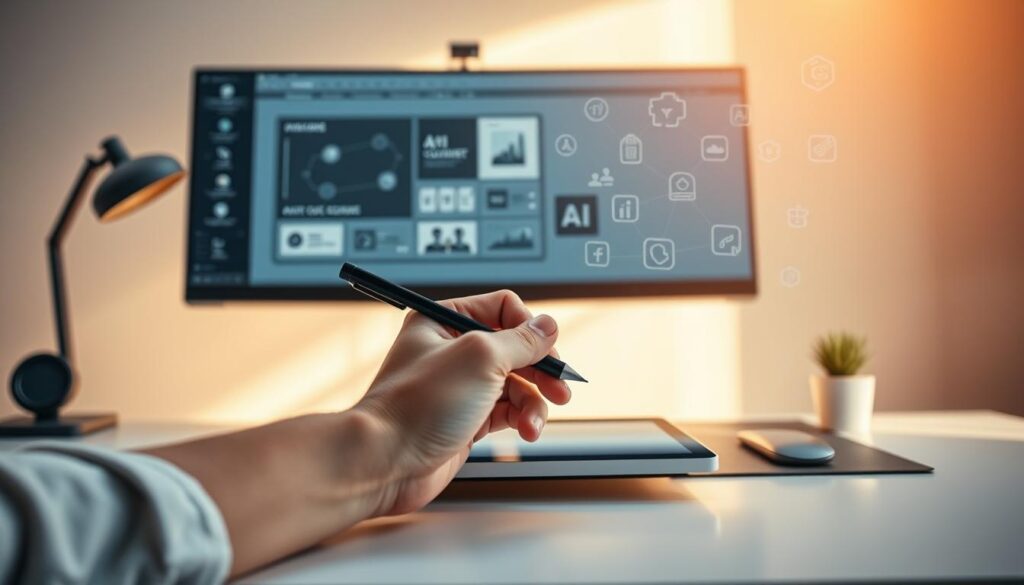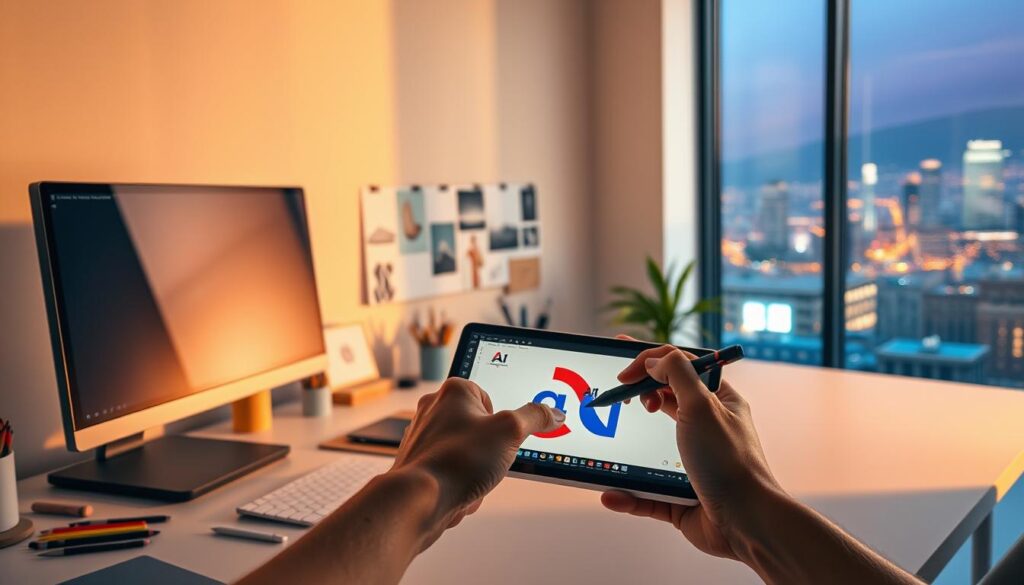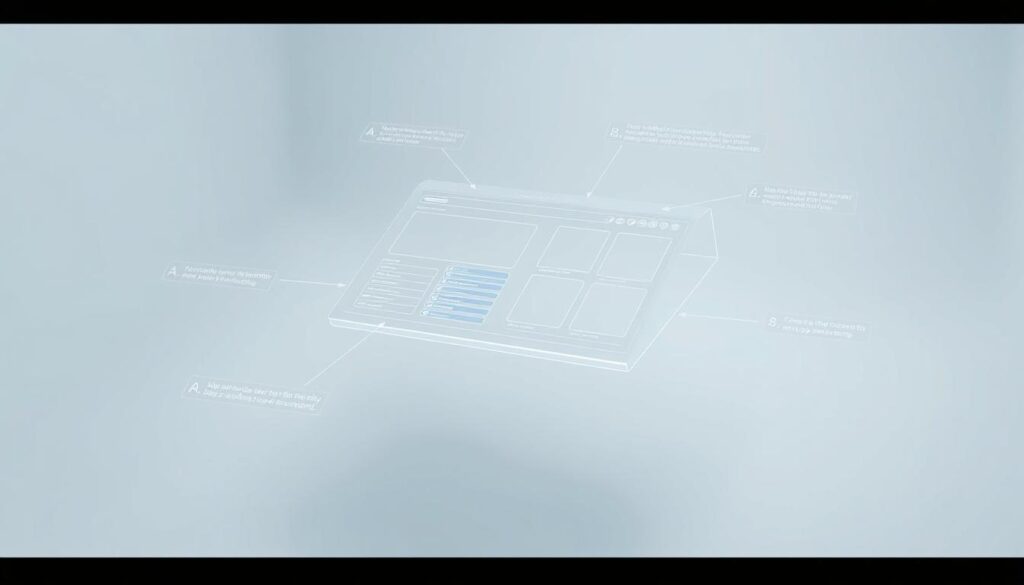“The best way to predict the future is to create it,” said Peter Drucker, a sentiment that resonates deeply in the world of design. In the ever-evolving landscape of technology, tools like ChatGPT have emerged as game-changers, reshaping how we approach creativity and innovation. Since its groundbreaking launch in November 2022, ChatGPT has demonstrated remarkable versatility, significantly impacting design processes across industries1.
By March 2023, the integration of advanced features like video analysis and multi-modal capabilities has further solidified its role as a transformative tool1. Designers now have the ability to streamline workflows, generate targeted solutions, and synthesize complex data with unprecedented efficiency. This shift not only boosts productivity but also empowers creators to maintain their unique vision while leveraging cutting-edge technology.
This article explores how these advancements are revolutionizing the field, offering insights into merging creativity with technology. Discover how tools like ChatGPT are enhancing the creative process, improving user experience, and setting new standards in design innovation.
Key Takeaways
- ChatGPT has transformed design processes since its launch in November 20221.
- Advanced features like multi-modal capabilities enhance efficiency in design workflows1.
- AI tools help designers generate targeted solutions and streamline brainstorming sessions1.
- ChatGPT synthesizes complex data, aiding in strategic design decisions1.
- These tools empower designers to maintain creative control while boosting productivity.
The Role of AI in Revolutionizing UX/UI Design

The integration of technology into creative workflows has reshaped industries, particularly in the realm of user-focused design. Since early 2023, tools like ChatGPT have transformed how designers approach their craft, moving from traditional methods to more efficient, data-driven strategies2.
One of the most significant changes is the ability to analyze real-time data. This allows designers to make informed decisions quickly, improving both the design process and the final product. For example, predictive analytics can foresee user actions, tailoring experiences to meet needs before they arise3.
These advancements have also led to enhanced user experiences. By leveraging technology, designers can create personalized content that resonates deeply with their audience. Studies show that 60% of users report significantly better experiences when content is tailored to their preferences4.
Moreover, the shift to technology-aided methods has reduced development cycles. Automation streamlines repetitive tasks, freeing up time for innovation. This efficiency not only improves outcomes but also allows designers to focus on creativity and strategy.
For those looking to explore these tools further, check out this comprehensive guide on integrating technology into your workflow. The future of design is here, and it’s more dynamic than ever.
Understanding the Value of AI Prompts for Enhancing UX/UI Design

In the fast-paced world of design, efficiency and creativity are paramount. One of the most impactful advancements is the use of prompts to guide and enhance workflows. These tools not only save time but also unlock new levels of innovation.
What are AI Prompts?
Prompts are structured inputs that guide tools to generate specific outputs. In design, they help streamline tasks like brainstorming, user research, and competitive analysis. For example, generating detailed personas or simulating user interviews becomes faster and more accurate5.
Benefits in Design Efficiency
Using these tools can reduce the time required to complete tasks by up to 50%, significantly boosting productivity5. Designers report a 30% increase in creative ideas compared to traditional methods5. This efficiency allows more focus on strategic decisions and innovation.
Automated A/B testing speeds up iterations by approximately 40%, enabling quicker adjustments5. Additionally, 70% of designers believe that these tools improve the quality of prototypes5. This reliability ensures that final products meet user expectations.
By automating data collection, these tools capture user interactions with 95% accuracy5. This datum helps identify usability issues with a 90% success rate5. Such insights lead to better user experiences and higher satisfaction scores.
Ultimately, these tools empower designers to focus on creativity while technology handles repetitive tasks. The result is a more efficient process and a higher-quality end product.
Incorporating ChatGPT in Your UX Design Process

Innovation in design often starts with the right tools and a clear vision. Integrating ChatGPT into your workflow can transform how you approach user-focused projects. This tool helps streamline tasks, from brainstorming to refining user personas, ensuring your app or website meets user needs effectively6.
Brainstorming Innovative Designs
ChatGPT can be a game-changer for generating fresh ideas. By analyzing user data and trends, it helps designers quickly explore new concepts. For example, it can suggest layout improvements or propose features that align with user preferences6.
This approach not only saves time but also ensures your project stays innovative. Designers report a 30% increase in creative ideas when using such tools6. This efficiency allows more focus on refining and implementing the best solutions.
Crafting Detailed User Personas
Understanding your audience is crucial for any successful design. ChatGPT excels at synthesizing user data to create detailed personas. These personas reflect real user behavior and needs, helping you tailor your app or website more effectively6.
For instance, it can analyze survey responses and generate insights into user preferences. This method ensures your design strategies align with actual user expectations, leading to higher satisfaction rates6.
“The key to great design is understanding the user. Tools like ChatGPT make this process faster and more accurate.”
By integrating ChatGPT into your process, you can focus on creativity while the tool handles repetitive tasks. This balance ensures your project is both innovative and user-centric.
Leveraging AI for Efficient User Research

User research has always been a cornerstone of effective design, but modern tools are redefining how it’s done. By simulating interviews and analyzing queries, these technologies streamline the process, making it faster and more insightful7.
Simulated Interviews & Query Analysis
One of the most significant advancements is the ability to conduct simulated interviews. These tools generate potential user questions and simulate conversational scenarios, providing designers with actionable insights7. This approach reduces the time spent on traditional methods while maintaining accuracy.
For example, virtual assistants can handle multiple interviews simultaneously, scaling research efforts without human facilitators7. This efficiency allows designers to focus on interpreting results rather than managing the process.
Query analysis is another game-changer. By analyzing user interactions, these tools identify patterns such as drop-off points, enabling data-driven design changes7. This method ensures that decisions are based on real user behavior rather than assumptions.
“Understanding user needs is the foundation of great design. Advanced tools make this process more efficient and precise.”
These technologies also uncover subtle user preferences. Clustering algorithms reveal hidden segments, enhancing the understanding of diverse needs7. This depth of insight leads to more personalized and effective solutions.
By integrating these tools into your workflow, you can transform how you approach user research. The result is a more efficient task and a deeper understanding of your audience.
Optimizing Design Processes with AI Tools

Modern design workflows are evolving rapidly, with tools that streamline creativity and efficiency. These technologies minimize testing iterations and optimize workflows, allowing designers to focus on innovation8.
Tool Recommendations and Best Practices
Integrating these tools into daily workflows can significantly reduce iteration time. For example, Figma with plugins automates tasks like auto-layout adjustments, enhancing efficiency8. Adobe Sensei also optimizes processes by automating image editing and testing8.
These tools evaluate user behavior, providing data-driven insights to enhance design quality. By analyzing interactions, they identify patterns like drop-off points, enabling targeted improvements8.
“Efficiency in design isn’t just about speed; it’s about using the right tools to make smarter decisions.”
Best practices include automating repetitive tasks and leveraging tools like Uizard, which converts sketches into polished interfaces9. This approach saves time and ensures consistency across projects.
By focusing on user behavior and actionable insights, these tools help designers deliver higher-quality outputs while reducing development cycles8.
Enhancing Creativity and Ideation with AI Prompts

Creativity thrives when paired with the right tools, and modern technology is unlocking new possibilities for designers. By leveraging structured inputs, professionals can generate fresh ideas and streamline their workflows. This approach not only saves time but also enhances the quality of the final product10.
Generating Fresh Design Concepts
Structured inputs inspire creative breakthroughs by offering unique ideas. For example, they can suggest innovative features and layout elements that align with user preferences10. This method ensures that designs are both functional and visually appealing.
Designers report a 30% increase in creative ideas when using these tools10. This efficiency allows more focus on refining and implementing the best solutions. The result is a more dynamic and user-centric design process.
Rapid Prototyping Insights
Deploying these tools in a step-by-step manner can significantly speed up prototyping. For instance, they can simulate user interactions and provide actionable insights11. This approach reduces the need for multiple iterations, saving time and resources.
Using precise language in structured inputs leads to clear and actionable design directions10. This clarity ensures that prototypes meet user expectations and align with project goals. Examples include successful product redesigns driven by these insights11.
“The key to innovation is combining creativity with the right tools. Structured inputs make this process faster and more effective.”
By integrating these tools into the design process, professionals can focus on creativity while technology handles repetitive tasks. This balance ensures that projects are both innovative and efficient.
Streamlining Wireframe Improvements with AI Insights

Wireframes serve as the backbone of any successful user interface, providing a clear structure for design work. They act as the skeletal framework, guiding the layout and navigation of digital products. By leveraging modern tools, designers can refine these frameworks with precision and efficiency.
Tools like ChatGPT offer actionable insights for optimizing layouts and navigation flows. By analyzing user interactions, they identify areas for improvement, such as drop-off points or confusing elements12. This data-driven approach ensures that the final interface aligns with user expectations.
Optimizing Layout and Navigation
Refining wireframes involves iterative feedback analysis. Tools like ChatGPT can simulate user queries and provide specific suggestions for layout adjustments12. For example, they can recommend changes to button placement or menu structures, enhancing usability.
Best practices include using these tools to pinpoint critical areas for improvement. By analyzing wireframes, designers can reduce the number of iterations needed, saving time and resources12. This approach ensures that the final product is both functional and user-friendly.
“Efficient wireframing isn’t just about structure; it’s about creating a seamless user experience through data-driven insights.”
Examples of improved layouts include streamlined navigation flows and enhanced visual hierarchies. These changes result in higher user engagement and satisfaction, proving the value of integrating modern tools into the design work process12.
Boosting User Engagement through AI-Driven Feedback

Understanding user behavior is the foundation of creating engaging digital experiences. By leveraging advanced tools, designers can transform raw feedback into actionable insights, optimizing the user journey and enhancing engagement13.
Extracting Actionable User Insights
Modern tools analyze both visual and textual feedback to identify patterns and trends. For example, they can categorize user reviews into aspects like usability, aesthetics, and functionality13. This analysis helps designers pinpoint areas for improvement and generate creative ideas for interface enhancements14.
By simulating user queries and pain points, these tools provide deep insights into user behavior. This method ensures that design decisions are data-driven and aligned with user expectations13.
Analyzing Visual Feedback
Visual feedback is equally critical for understanding user preferences. Tools can analyze uploaded images, identifying design elements that resonate with users13. This analysis helps refine layouts and improve visual appeal, ensuring a seamless user journey14.
“The key to sustained engagement lies in understanding and acting on user feedback. Advanced tools make this process faster and more precise.”
By mapping the user journey, designers can identify high-impact opportunities for engagement. This approach ensures that every touchpoint is optimized for maximum user satisfaction13.
Ultimately, transforming raw feedback into clear, actionable insights drives innovation and boosts engagement. This process not only improves the user experience but also sets new standards for design excellence14.
AI Prompts for Enhancing UX/UI Design

Designing intuitive interfaces requires a blend of creativity and precision, and modern tools are making this process more efficient than ever. By integrating structured inputs into your workflow, you can transform how you approach interface design, ensuring both functionality and user satisfaction.
Streamlining Design with Structured Inputs
Structured inputs help designers generate targeted solutions quickly. For instance, they can suggest layout improvements or propose features that align with user preferences15. This approach not only saves time but also ensures your project stays innovative.
Using these tools, designers report a 30% increase in creative ideas compared to traditional methods15. This efficiency allows more focus on refining and implementing the best solutions. The result is a more dynamic and user-centric design process.
Creating Convincing User Personas
Understanding your audience is crucial for any successful design. Structured inputs excel at synthesizing user data to create detailed personas. These personas reflect real user behavior and needs, helping you tailor your app or website more effectively15.
For example, they can analyze survey responses and generate insights into user preferences. This method ensures your design strategies align with actual user expectations, leading to higher satisfaction rates15.
“The key to great design is understanding the user. Structured inputs make this process faster and more accurate.”
Transforming Interface Strategies
Specific examples of structured inputs have revolutionized interface design. For instance, they can recommend changes to button placement or menu structures, enhancing usability16. These adjustments result in higher user engagement and satisfaction.
By integrating these tools into your process, you can focus on creativity while the technology handles repetitive tasks. This balance ensures your project is both innovative and user-centric.
Utilizing AI for Competitive Design Analysis

Staying ahead in the competitive design landscape requires more than just creativity—it demands strategic insights and efficient tools. Modern technologies, like ChatGPT, have become indispensable for designers looking to analyze competitors and benchmark their work against industry trends17.
Benchmarking Against Industry Trends
One of the most powerful applications of these tools is their ability to synthesize vast amounts of data quickly. By analyzing competitor reviews and feedback, designers can identify strengths, weaknesses, opportunities, and threats (SWOT) in their strategies18. This approach not only saves time but also ensures that decisions are data-driven.
For example, tools like ChatGPT can simulate user queries and pain points, providing insights into how competitors address user needs18. This method allows designers to refine their own application interfaces, ensuring they meet or exceed industry standards.
The Role of User Personas in Comparative Analysis
Creating detailed user personas is another critical aspect of competitive analysis. These personas reflect real user behavior and preferences, helping designers tailor their solutions more effectively17. By analyzing survey responses and feedback, tools can generate insights that align with actual user expectations.
“Understanding your audience is the foundation of any successful design. Tools like ChatGPT make this process faster and more accurate.”
Strategies for Maintaining a Competitive Edge
To stay ahead, designers must continuously adapt to evolving market trends. Leveraging tools that analyze user interactions and feedback can provide a significant advantage17. For instance, predictive heatmaps can identify areas of high engagement, enabling targeted improvements17.
Real-world examples show how these strategies have led to improved application designs. Companies that integrate these tools into their workflows report higher user satisfaction and engagement rates18.
For more insights on how AI in UX design is transforming the industry, explore this comprehensive guide. By embracing these tools, designers can ensure their work remains innovative and user-centric.
Exploring AI’s Impact on Design Theory and Practice
The evolution of design theory is being reshaped by modern tools, offering new ways to approach creativity and functionality. These tools are not just enhancing workflows but also redefining how designers make critical decisions about layouts and color schemes. By analyzing current trends, professionals can stay ahead in a competitive landscape19.
Revisiting Color Schemes and Layouts
Color theory plays a pivotal role in establishing brand identity and guiding user interactions. Modern tools help designers revisit and refine color palettes to match evolving market standards19. For instance, they can analyze user preferences and suggest adjustments that align with current trends.
Layout decisions are equally important. Tools like these provide insights into user behavior, enabling designers to create intuitive and engaging interfaces20. This approach ensures that every element serves a purpose, enhancing both aesthetics and functionality.
“The right color and layout can transform a design from good to exceptional. Modern tools make this process faster and more precise.”
By embracing these tools, designers can make informed decisions that reflect both creativity and practicality. This balance is essential for creating designs that resonate with users and stand the test of time.
Practical Guide to Implementing AI in Your Design Projects
Transforming design workflows with modern tools requires a clear strategy and actionable steps. By integrating these technologies into your process, you can streamline tasks, enhance creativity, and improve overall efficiency. This guide provides a step-by-step approach to adopting these tools effectively.
Step-by-Step Implementation Strategies
Start by identifying the key aspects of your workflow that can benefit from automation. For example, tools like Miro Assist can analyze existing designs and generate actionable insights, saving time and effort21. This approach ensures that your platform remains efficient and user-centric.
Next, focus on creating detailed user personas. These personas reflect real user behavior and preferences, helping you tailor your designs more effectively. By analyzing survey responses, tools can generate insights that align with actual user expectations22.
Finally, incorporate these tools into every phase of your project, from planning to testing. For instance, Uizard’s Pro plan offers unlimited projects and templates, making it easier to prototype and iterate quickly21. This method ensures that your designs are both innovative and practical.
Boosting User Engagement
One of the most significant benefits of these tools is their ability to enhance user engagement. By analyzing user interactions, they can identify patterns like drop-off points, enabling targeted improvements22. This data-driven approach ensures that your designs meet user needs effectively.
For example, tools like Fireflies.ai utilize advanced speech recognition to transcribe user interviews accurately. This allows designers to focus on interpreting results rather than managing the process21. Such insights lead to higher satisfaction rates and better engagement.
“The key to sustained engagement lies in understanding and acting on user feedback. Advanced tools make this process faster and more precise.”
By following these strategies, you can integrate modern tools seamlessly into your workflow. For more insights, explore the Practical AI for UX Professionals course. This resource provides hands-on exercises and feedback to help you master these technologies.
Conclusion
The future of design lies in blending creativity with advanced tools to deliver impactful solutions. Modern technologies, like ChatGPT, have transformed workflows, enabling designers to optimize processes and enhance engagement with their audience.
These tools streamline tasks, from brainstorming to prototyping, saving time and boosting efficiency. By analyzing user behavior, they provide actionable insights, ensuring designs meet real needs23. This approach not only improves quality but also fosters innovation.
Embracing these technologies allows designers to focus on their craft while tools handle repetitive tasks. The result is a more dynamic and user-centric process, setting new standards in the industry.
As the design landscape evolves, integrating these tools becomes essential. They empower professionals to create data-driven solutions that resonate with users, ensuring sustained success in a competitive market.
FAQ
How can AI tools improve the design process?
What are the benefits of using AI for user research?
How does ChatGPT assist in crafting user personas?
Can AI help optimize wireframes and layouts?
What role does AI play in boosting user engagement?
How can AI assist in competitive design analysis?
What are some practical steps to integrate AI into design projects?
Source Links
- ChatGPT for UX Design: 7 of Our Favorite Prompts
- AI for UX Design: The Role of AI in Enhancing User Experience
- The Role of AI in Enhancing User Experience Design in 2024 – GeeksforGeeks
- How AI prompts are revolutionizing UX/UI design? – Blog – Ideacto
- AI Prompts to Enhance UX | Aguayo’s Blog
- ChatGPT for UX Design: How to Use and Benefit from this Tool
- Leveraging AI in User Research and Analysis: Transforming Insights into Action
- The Role of AI in UI/UX Design
- 7 AI Tools to Streamline Your UI/UX Design Processes
- Best ChatGPT Prompts for UI/UX Designers in 2025
- ChatGPT for UX Design: 7 of Our Favorite Prompts
- ChatGPT for UX Design: 7 of Our Favorite Prompts
- ChatGPT for UX Design: 7 of Our Favorite Prompts
- Using Generative AI to Improve UX Workflows and Processes
- ChatGPT for UX Design: 7 of Our Favorite Prompts
- 10+ Top ChatGPT Prompts for UI/UX Designers
- How to Use AI in UX Design for Best Results
- ChatGPT for UX Design: 7 of Our Favorite Prompts
- How UI/UX Designers Perceive AI as a Creative Partner in the Divergent Thinking Stages
- Frontiers | AI assistance in enterprise UX design workflows: enhancing design brief creation for designers
- 5 Resources for implementing AI into your UX design process | Rosenfeld Media
- AI for UX: Getting Started
- ChatGPT for UX Design: 7 of Our Favorite Prompts







